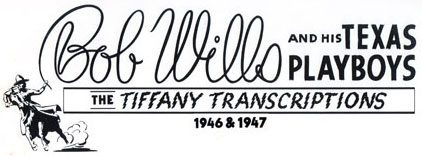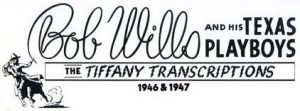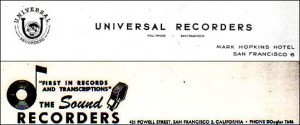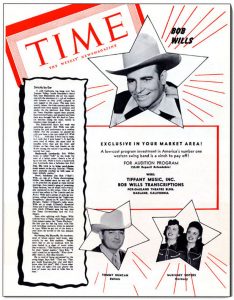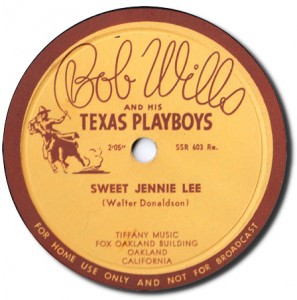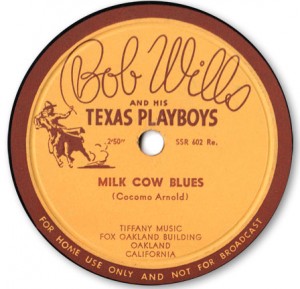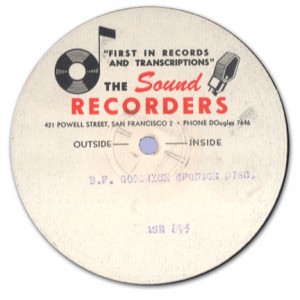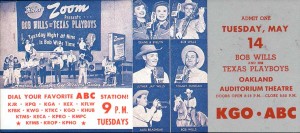The Tiffany Music Company
To me it’s a page in my life I’d like to forget. – Cliff Sundin
updated 06/2/2020 (Be sure to click on all the links and footnotes to understand the complete story.)
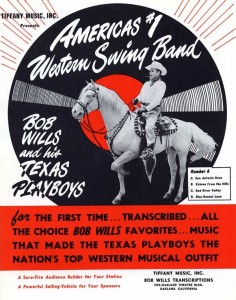
First of all, they were never officially called the Tiffany Transcriptions. They were called the Bob Wills Transcriptions (or Bob Wills and his Texas Playboys Transcriptions as on the actual transcriptions labels.) Recorded in 1946 and 1947 they were produced by Tiffany Music Incorporated located in the Fox Oakland Building in Oakland, California. But everyone called them the Tiffany Transcriptions and they were legendary. For years collectors passed copies of them around on poorly dubbed reel to reel tapes, and later on cassette. But those tapes contained less than one half of the recorded output of Tiffany sessions. The information about the recordings, what songs were recorded, how many, the exact recording dates, who the musicians were on them, and the entire circumstances of Tiffany Music Inc. was unknown. This is the story as we know it today, but it keeps changing as more information is discovered.
The Tiffany Music Company was formed sometime in 1945 1 by band leader Bob Wills, songwriter Cliff Sundin, and radio personality Clifton Johnsen, known on the air as “Cactus Jack”. Cliff Sundin, who apparently financed much of the enterprise, had three of his songs recorded by Wills in 1945: Stars and Stripes on Iwo Jima (for which he gets no credit either on the label of the Wills recording or subsequently on the Harry Fox or BMI websites), Empty Chair at the Christmas Table, and White Cross on Okinawa. Cactus Jack was a well known radio DJ who had success on the radio playing the music of the Southwest to the many transplants from that region who had come to the San Francisco Bay Area to work during the war. Bob Wills was one of the top band leaders in the country and had moved to California from his original base in Texas and Oklahoma to try to create a touring circuit on the West Coast.
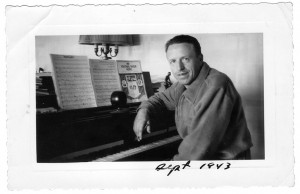
The idea behind the Tiffany Transcriptions was to create a transcribed Bob Wills radio show that could be syndicated to radio stations all across America. The music would be supplied on 16-inch transcription discs, which were the standard of the day for distributing syndicated radio shows to stations in the pre-tape (and now digital) days.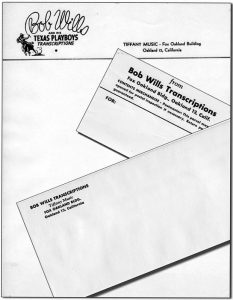
This service was available to stations from 1947 through 1949. The company was ready for success; they printed hundreds of transcription labels, ready to be applied to the discs when they were ordered, hundreds of the famous Tiffany Promotional Flyer, posters, advertising graphics, as well as stationery, envelopes, package address labels, everything to turn out transcriptions to hundreds of stations nationwide. But the success that they hoped for was not to be.
The Recordings
As far as we know, there were thirteen or fourteen recording sessions, eight in 1946 and five or six in 1947 (see discography for details). The 1946 recording sessions were held in San Francisco at Universal Studios, in the basement of the Mark Hopkins Hotel atop San Francisco’s famous, and famously steep, Nob Hill. Fiddler Joe Holley recalled, “The only problem was getting that big long bus to the top of Nob Hill. It took some real maneuvering to find a suitable route over those narrow hilly streets.” M.H. DeWitt is believed to have been the recording engineer.
In 1947 the sessions were held at Sound Recorders, 421 Powell Street at the foot of Nob Hill. Jack Hawkins is believed to have been the recording engineer.
The sessions were usually held on a Monday, a day the band wasn’t touring or performing. These sessions were not treated like many of their regular sessions for record labels. They were far more casual, involved very little planning, and usually musical arrangements were made on the spot. They were cut live onto 16-inch or 17-inch acetate master discs at 331/3 rpm, usually three or four songs per disc. This allowed some of the songs to be longer than the normal three minute limitation of a standard 10-inch 78 rpm commercial record. Many songs are over three minutes in length, and several are over four minutes, while St. Louis Blues (Part 2) is five seconds short of being six minutes in length.
The songs ranged from Bob Wills hits, western swing standards, and top hits of the day, to sentimental ballads, western movie cowboy songs, Texas fiddle tunes, blues, and hot swing instrumentals. They were loose, raw, energetic, and well recorded. The Wills band at that time was a stripped-down version of his big band orchestras of the ’30s and early ’40s. Down to one horn (Alex Brashear – trumpet), the electric guitar, steel guitar, and electric mandolin stepped up to fill the gap. They wailed and were fearless.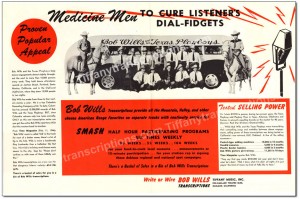
Many years later band members recalled the sessions in the notes to the Kaleidoscope Records reissues:
Steel guitar player Herb Remington: “…I remember just how relaxed and ‘off the cuff’ the mood of the band was each time we recorded the Tiffany Transcriptions. We were usually between tours when we did them: periods when we were not in a big rush and we were rested and just having fun. You can feel it when you listen.”
Fiddler Joe Holley: “…They were unique because Bob did not rehearse the band. We simply set up and played as if it was a dance. Everything was spontaneous – in Bob’s words, ‘not so cut and dried.’ ”
Steel guitar player Roy Honeycutt: “…The band would usually tour all week and end up in Oakland for the weekend. Then Monday morning we would all head out in the bus together to the recording studio up on Nob Hill. We’d usually record, without any rehearsal, until Bob figured we’d had enough for one day. He would usually listen to a lot of it afterwards to see what he thought, and then we’d all take the bus back to Oakland for another week of touring.”
Electric mandolin player Tiny Moore: “…This is the way the Wills Band sounded on the many dances we played. In not trying to get the ‘perfect take’ we had a relaxed yet driving quality that is hard to get on a record. I don’t remember any pressure at all during these sessions. It was fun!”
During 1946 and 1947 the band recorded over 458 individual tracks, including complete takes, incomplete takes, false starts, intros, outros, mic checks, etc. Of these, 360 were complete takes. From the complete takes, 213 were issued on the original 26 transcription discs (this includes the opening and closing theme).
The Discs
The Tiffany Transcriptions were recorded between 1946 and 1947 in San Francisco onto 16- or 17-inch acetate master discs, usually going at 331/3 rpm. There were a few that were recorded at 331/3 for the first songs of the disc and then 78 rpm for the last song. This helped minimize inner groove distortion (the inner grooves of the spiral of a record contain the same amount of information as the outer grooves, but have a much smaller diameter, so the information is more compressed together and more likely to have distortion).
On the Tiffany Transcriptions Bob Wills and His Texas Playboys recorded only the music, no talking or introductions. Songs were then selected from the masters and assembled on the transcription discs which were pressed on both black and red vinyl. They were 16-inch discs, which played at 331/3 rpm — this was the radio transcription standard size and speed. (They were not the 331/3 micro groove recordings that were later introduced in the 1950’s for home use; these were played with the same diameter stylus as 78 rpm records and were only used in the radio industry.) Each side of a disc was indicated as a “record” so “record number one” had “record number two” on its flip side. 26 discs (or 52 “records”) were completed yet only 24 discs were ever distributed to the radio stations. There were generally four or five songs to a side.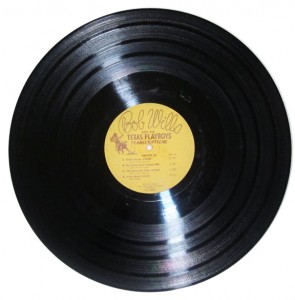
The Transcription Radio Show
The Tiffany Music Company hoped to syndicate the radio show to stations throughout the United States. The stations would enter into an agreement 2 with the Tiffany Music Company to broadcast the shows and would be sent an initial set of transcriptions, to be supplemented with new ones as they were recorded. The discs were not meant to be played all the way through, and in fact it was impossible to do so, since there was a locked-groove at the end of each song so it would not track to the next song. The discs were supplied along with a script (called a Continuity – view a continuity 3)
The radio station would have a local announcer host the show, read the continuity and then play the song indicated by the transcription record number and track number (or track letter as they were designated). This way, with a set of transcriptions, the songs could be shuffled to create an infinite number of shows. The station would sell local advertising and the host would give it a local flavor. Each show started out with the Texas Playboys Theme intro, and ended with the outro theme. This theme was adapted from an old hokum blues song, “Eagle Ridin’ Papa”, recorded by Georgia Tom Dorsey on July 8, 1929. (A detailed discussion with audio samples of the Playboy Theme 4)
There is evidence that the Tiffany Music Company was planning on releasing a commercial 10-inch 78 rpm record for sale to the public. Although the Tiffany Music Company kept very good business records and Cliff Sundin saved most of those records to be discovered 50 years later, there is no information about the 78. There is only one issue, a 10-inch 78 rpm record with Milk Cow Blues on one side and Sweet Jennie Lee on the other. Less than 10 copies of this record have surfaced, making it an extremely rare disc. The Country Music Foundation has one that differs from the one shown here in that it has “Vocal by Tommy Duncan” stamped on the label. Since very few seemed to have been made, they were probably test pressings, although they do have official labels on them.
Was this an attempt to release the recordings to the public? In 1946 Bob Wills was recording for Columbia Records as he had been since 1935. His last session for Columbia was on October 16, 1947 in Chicago. He then signed with MGM Records and started recording for them on October 30, 1947 in Los Angeles. Since he was under contract to either Columbia or MGM to release his commercial discs, it doesn’t seem likely that the Tiffany Music Company would have been allowed to release a 78 during that time. Did they plan to release 78s but then realize the contractual conflicts? No information has yet been discovered.
The B.F. Goodrich Show
Around 1948 there was a sponsorship plan for a B.F. Goodrich-sponsored Bob Wills show based on the Tiffany Transcriptions, with Bob Wills and Cactus Jack hosting. Bob Wills and Cactus Jack recorded several intros and outros for the show, and one complete transcription show was recorded and pressed. But it doesn’t look like it ever got off the ground. The discs that were found look like they were never sent out, and the complete story is unknown.
In 1946 Bob Wills started a weekly radio show on KGO-AM out of San Francisco, California. The show was supposed to be live, broadcast from across the Bay at the Oakland Auditorium Theater.
The show was introduced by Jack Webb (later of TV’s “Dragnet” fame), MC’ed by Cactus Jack, and sponsored by Zoom cereal. During the Tiffany Transcriptions recording sessions, the band recorded a Zoom Cereal jingle using Junior Barnard’s signature guitar lick at the end.
However, because of Wills’ touring schedule, he was not able to make all the shows, and it is likely that recorded material was used to create a show not unlike the Tiffany Transcriptions programs. The theme to the show was San Antonio Rose, and whether Tiffany Transcriptions recordings were used during the show is unknown. For more information and audio samples…
In 1949 things were not looking good for the Tiffany Music Company.
“It was the culmination of many little things” – Cliff Sundin
Sundin claims things were going well, and the transcriptions were successful, if only still just starting out. Whether this is true or not is unkown. Kaleidoscope Records, who later reissued the Tiffany Transcriptions, found only 34 subscribing stations noted in the Tiffany Transcriptions financial records. (see list of stations 5) How many stations actually subscribed is unknown, however, other trouble was brewing.
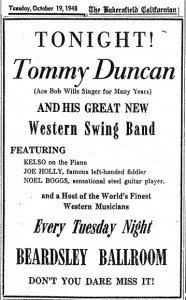
In 1948 Tommy Duncan, lead singer of the Texas Playboys since the very origins of the band, was fired. When he left, Joe Holley, Millard Kelso and Ocie Stockard left with him and Duncan started his own band. This band followed the same touring route as the Wills band and competed for bookings. Chip Esley who was representing Bob Wills’ at the time (either as his lawyer or business manager) told Sundin that they would have to cancel the transcriptions because of the publicity it was giving Tommy Duncan (Tommy, being the lead singer, was a popular personality and a major component of the Wills sound. He was the main singer on the Tiffany Transcriptions.) In a recently discovered phone interview from the mid-1970’s between Wills biographer Charles Townsend and Cliff Sundin (recorded by Sundin), Townsend directly asks “In other words, one reason you stopped making them was that break up with Tommy” Sundin replies “Yes that was the main thing”
“We just seemed to run into one damn crook after another.” – Cliff Sundin
Then Cactus Jack was accused of all manner of crooked dealings. According to Sundin, Cactus Jack apparently manufactured and sold copies of the Transcriptions to radio stations on the side without reporting it to his partners (or sharing in the profits).
“Cactus Jack, his wife, she was not his wife at that time, but she was in charge of the office and anything they didn’t want me to see, why I didn’t see it.” – Cliff Sundin
There were other accusations against Cactus Jack as well.
“In the music business I don’t think I’ve ever met so people who were, were so ….crooked, I’ll just say crooked….see.” – Cliff Sundin
There was the alcoholic salesman who was making deals for the Tiffany Transcriptions that the company was unable to deliver on.
Sundin: “…he sold stuff we couldn’t produce. …the guy turned out to be an alcoholic, you’d send him on the road…we wouldn’t hear from him. I’d get a bunch of telephone bills and everything else…I’d pay them all and we all took it in good stride..see. .This whole thing was cockeyed right from the start.”
On January 10, 1949, due to his shady dealings, Cactus Jack was forced out of the company. In the agreement at the Board of Directors meeting dated, January 10, 1949, Cactus Jack gave up his rights to the Tiffany Transcriptions 6. This left Cliff Sundin and Bob Wills as the sole owners of the company.
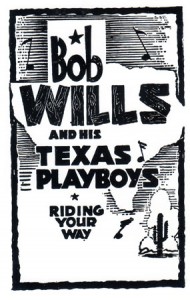 Here’s a portion of a telephone call from the early 1950’s between Cliff Sundin and Bob Wills talking about Cactus Jack (sorry about the bad quality of Bob’s phone connection). Note that Sundin mentions going to see the Wills band, but Wills didn’t show up, a common problem around that time.
Here’s a portion of a telephone call from the early 1950’s between Cliff Sundin and Bob Wills talking about Cactus Jack (sorry about the bad quality of Bob’s phone connection). Note that Sundin mentions going to see the Wills band, but Wills didn’t show up, a common problem around that time.
At that same meeting on January 10, 1949, it was decided to cease all distribution of the transcriptions, and recall those that had been sent out. (the minutes of that meeting 7) From the idea that started in 1945, to the recordings made in 1946 & ’47, to the distribution of those recordings to radio stations, the active part of the company lasted a little more than three short years.
There is no record of any further activity until 1953, when Bob Wills turned his rights over to Cliff Sundin in exchange for $1.00 8. Upon receiving Wills’ signed agreement, Sundin wrote a letter to Wills and was apologetic about the failure of the business but expressed hopes that there still might be a future for the transcription service: “I am sorry that the transcription deal did not turn out so well for us both. However I have had several inquiries and now feel free to follow them up. If something worthwhile should materialize, and the service could be brought up to date, with a few new recordings, I know you will go along as discussed, at Union scale, and again place it on the market.” Sundin also pitched three new songs to Wills. (view complete letter 9).
Apparently nothing came of these “inquiries” and Cliff Sundin packed up everything and put it in the basement of his house on School Street in Oakland, California, where it sat for many years.
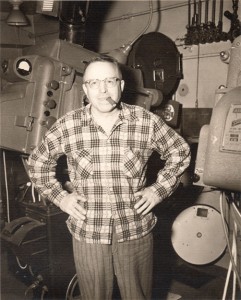
After Cliff Sundin gave up on the Tiffany Music Company, he continued writing songs and worked for many years as a movie projectionist at Oakland movie theaters. He never forgot about the music recorded by the Tiffany Music Company. His granddaughter, Nancy Telles, remembers him constantly playing Bob Wills around the house while she was growing up (much to her embarrassment when her friends heard the music). But he did not try to revive the company or do anything with the recordings. Collectors of Bob Wills music passed tapes around of many of the transcriptions and they attained legendary status.
In 1976, when Charles Townsend wrote his book San Antonio Rose: the Life and Times of Bob Wills, it came with a Bob Wills discography written and researched by the late Bob Pinson of the Country Music Foundation. Included in this discography were all the songs released on the twenty-six Tiffany Transcription discs, but none of the unissued ones. There were errors in the discography, including the dates and the personnel. Unfortunately, the book and discography have not been updated, so these errors have been repeated. Bob Pinson, long time Wills fan and collector, and head of the County Music Foundation’s archive, was a tireless researcher of the recordings of Bob Wills. Yet with all the resources available to him, he put at the bottom of the discography the statement “…all efforts to secure the necessary information about the entire catalog of Tiffany Recordings from the possessor of these data have been in vain.”
The Tiffany Transcriptions project turned out to be a bad experience for Sundin and it seems he just didn’t want to revisit it.
Next: More trouble for Cliff, The Tishomingo / Lariat Records reissues.
Please do not reprint anything on this website without permission from tiffanytranscriptions@gmail.com
The Tiffany Music Company
To me it’s a page in my life I’d like to forget. – Cliff Sundin
updated 06/2/2020 (Be sure to click on all the links and footnotes to understand the complete story.)
 First of all, they were never called the Tiffany Transcriptions. They were called the Bob Wills Transcriptions (or Bob Wills and his Texas Playboys Transcriptions as on the actual transcriptions labels.) Recorded in 1946 and 1947 they were produced by Tiffany Music Incorporated located in the Fox Oakland Building in Oakland, California. But everyone called them the Tiffany Transcriptions and they were legendary. For years collectors passed copies of them around on poorly dubbed reel to reel tapes, and later on cassette. But those tapes contained less than one half of the recorded output of Tiffany sessions. The information about the recordings, what songs were recorded, how many, the exact recording dates, who were the musicians on them, and the entire circumstances of Tiffany Music Inc. was unknown. This is the story as we know it today, but it keeps changing as more information is discovered.
First of all, they were never called the Tiffany Transcriptions. They were called the Bob Wills Transcriptions (or Bob Wills and his Texas Playboys Transcriptions as on the actual transcriptions labels.) Recorded in 1946 and 1947 they were produced by Tiffany Music Incorporated located in the Fox Oakland Building in Oakland, California. But everyone called them the Tiffany Transcriptions and they were legendary. For years collectors passed copies of them around on poorly dubbed reel to reel tapes, and later on cassette. But those tapes contained less than one half of the recorded output of Tiffany sessions. The information about the recordings, what songs were recorded, how many, the exact recording dates, who were the musicians on them, and the entire circumstances of Tiffany Music Inc. was unknown. This is the story as we know it today, but it keeps changing as more information is discovered.
The Tiffany Music Company was formed sometime in 1945 1“by band leader Bob Wills, songwriter Cliff Sundin, and radio personality Cliffton Johnsen, known on the air as “Cactus Jack”. Cliff Sundin, who apparently financed much of the enterprise, had three of his songs recorded by Wills in 1945: Stars and Stripes on Iwo Jima (for which he gets no credit either on the label of the Wills recording or subsequently on the Harry Fox or BMI websites), Empty Chair at the Christmas Table, and White Cross on Okinawa. Cactus Jack was a well known radio DJ who had success on the radio playing the music of the Southwest to the many transplants from that region who had come to the San Francisco Bay Area to work during the war. Bob Wills was one of the top band leaders in the country and had moved to California from his original base in Texas and Oklahoma to try to create a touring circuit on the West Coast.

The idea behind the Tiffany Transcriptions was to create a transcribed Bob Wills radio show that could be syndicated to radio stations all across America. The music would be supplied on 16-inch transcription discs, which were the standard of the day for distributing syndicated radio shows to stations in the pre-tape (and now digital) days.
This service was available to stations from 1947 through 1949. The company was ready for success; they printed hundreds of transcription labels, ready to be applied to the discs when they were ordered, hundreds of the famous Tiffany Promotional Flyer, posters, advertising graphics, as well as stationery, envelopes, package address labels, everything to turn out transcriptions to hundreds of stations nationwide. But it was not to be.
The Recordings
As far as we know, there were thirteen or fourteen recording sessions, eight in 1946 and five or six in 1947 (see discography for details). The 1946 recording sessions were held in San Francisco at Universal Studios, in the basement of the Mark Hopkins Hotel atop San Francisco’s famous, and famously steep, Nob Hill. Fiddler Joe Holley recalled, “The only problem was getting that big long bus to the top of Nob Hill. It took some real maneuvering to find a suitable route over those narrow hilly streets.” M.H. DeWitt is believed to have been the recording engineer.
In 1947 the sessions were held at Sound Recorders, 421 Powell Street at the foot of Nob Hill. Jack Hawkins is believed to have been the recording engineer.
The sessions were usually held on a Monday, a day the band wasn’t touring or performing. These sessions were not treated like many of their regular sessions for record labels. They were far more casual, involved very little planning, and usually musical arrangements were made on the spot. They were cut live onto 16-inch or 17-inch acetate master discs at 331/3 rpm, usually three or four songs per disc. This allowed some of the songs to be longer than the normal three minute limitation of a standard 10-inch 78 rpm commercial record. Many songs are over three minutes in length, and several are over four minutes, while St. Louis Blues (Part 2) is five seconds short of being six minutes in length.
The songs ranged from Bob Wills hits, western swing standards, and top hits of the day, to sentimental ballads, western movie cowboy songs, Texas fiddle tunes, blues, and hot swing instrumentals. They were loose, raw, energetic, and well recorded. The Wills band at that time was a stripped-down version of his big band orchestras of the ’30s and early ’40s. Down to one horn (Alex Brashear – trumpet), the electric guitar, steel guitar, and electric mandolin stepped up to fill the gap. They wailed and were fearless.
Many years later band members recalled the sessions in the notes to the Kaleidoscope Records reissues:
Steel guitar player Herb Remington: “…I remember just how relaxed and ‘off the cuff’ the mood of the band was each time we recorded the Tiffany Transcriptions. We were usually between tours when we did them: periods when we were not in a big rush and we were rested and just having fun. You can feel it when you listen.”
Fiddler Joe Holley: “…They were unique because Bob did not rehearse the band. We simply set up and played as if it was a dance. Everything was spontaneous – in Bob’s words, ‘not so cut and dried.’ ”
Steel guitar player Roy Honeycutt: “…The band would usually tour all week and end up in Oakland for the weekend. Then Monday morning we would all head out in the bus together to the recording studio up on Nob Hill. We’d usually record, without any rehearsal, until Bob figured we’d had enough for one day. He would usually listen to a lot of it afterwards to see what he thought, and then we’d all take the bus back to Oakland for another week of touring.”
Electric mandolin player Tiny Moore: “…This is the way the Wills Band sounded on the many dances we played. In not trying to get the ‘perfect take’ we had a relaxed yet driving quality that is hard to get on a record. I don’t remember any pressure at all during these sessions. It was fun!”
During 1946 and 1947 the band recorded over 458 individual tracks, including complete takes, incomplete takes, false starts, intros, outros, mic checks, etc. Of these, 360 were complete takes. From the complete takes, 213 were issued on the original 26 transcription discs (this includes the opening and closing theme).
The Discs
The Tiffany Transcriptions were recorded between 1946 and 1947 in San Francisco onto 16- or 17-inch acetate master discs, usually going at 331/3 rpm. There were a few that were recorded at 331/3 for the first songs of the disc and then 78 rpm for the last song. This helped minimize inner groove distortion (the inner grooves of the spiral of a record contain the same amount of information as the outer grooves, but have a much smaller diameter, so the information is more compressed together and more likely to have distortion).
On the Tiffany Transcriptions Bob Wills and His Texas Playboys recorded only the music, no talking or introductions. Songs were then selected from the masters and assembled on the transcription discs which were pressed on both black and red vinyl. They were 16-inch discs, which played at 331/3 rpm — this was the radio transcription standard size and speed. (They were not the 331/3 micro groove recordings that were later introduced in the 1950’s for home use; these were played with the same diameter stylus as 78 rpm records and were only used in the radio industry.) Each side of a disc was indicated as a “record” so “record number one” had “record number two” on its flip side. 26 discs (or 52 “records”) were completed yet only 24 discs were ever distributed to the radio stations. There were generally four or five songs to a side.
The Transcription Radio Show
The Tiffany Music Company hoped to syndicate the radio show to stations throughout the United States. The stations would enter into an agreement 2 with the Tiffany Music Company to broadcast the shows and would be sent an initial set of transcriptions, to be supplemented with new ones as they were recorded. The discs were not meant to be played all the way through, and in fact it was impossible to do so, since there was a locked-groove at the end of each song so it would not track to the next song. The discs were supplied along with a script (called a Continuity – view a continuity 3)
The radio station would have a local announcer host the show, read the continuity and then play the song indicated by the transcription record number and track number (or track letter as they were designated). This way, with a set of transcriptions, the songs could be shuffled to create an infinite number of shows. The station would sell local advertising and the host would give it a local flavor. Each show started out with the Texas Playboys Theme intro, and ended with the outro theme. This theme was adapted from an old hokum blues song, “Eagle Ridin’ Papa”, recorded by Georgia Tom Dorsey on July 8, 1929. (A detailed discussion with audio samples of the Playboy Theme 4)
There is evidence that the Tiffany Music Company was planning on releasing a commercial 10-inch 78 rpm record for sale to the public. Although the Tiffany Music Company kept very good business records and Cliff Sundin saved most of those records to be discovered 50 years later, there is no information about the 78. There is only one issue, a 10-inch 78 rpm record with Milk Cow Blues on one side and Sweet Jennie Lee on the other. Less than 10 copies of this record have surfaced, making it an extremely rare disc. The Country Music Foundation has one that differs from the one shown here in that it has “Vocal by Tommy Duncan” stamped on the label. Since very few seemed to have been made, they were probably test pressings, although they do have official labels on them.
Was this an attempt to release the recordings to the public? In 1946 Bob Wills was recording for Columbia Records as he had been since 1935. His last session for Columbia was on October 16, 1947 in Chicago. He then signed with MGM Records and started recording for them on October 30, 1947 in Los Angeles. Since he was under contract to either Columbia or MGM to release his commercial discs, it doesn’t seem likely that the Tiffany Music Company would have been allowed to release a 78 during that time. Did they plan to release 78s but then realize the contractual conflicts? No information has yet been discovered.
Around 1948 there was a sponsorship plan for a B.F. Goodrich-sponsored Bob Wills show based on the Tiffany Transcriptions, with Bob Wills and Cactus Jack hosting. Bob Wills and Cactus Jack recorded several intros and outros for the show, and one complete transcription show was recorded and pressed. But it doesn’t look like it ever got off the ground. The discs that were found look like they were never sent out, and the complete story is unknown.
The Zoom Radio Show
In 1946 Bob Wills started a weekly radio show on KGO-AM out of San Francisco, California. The show was supposed to be live, broadcast from across the Bay at the Oakland Auditorium Theater.
The show was introduced by Jack Webb (later of TV’s “Dragnet” fame), MC’ed by Cactus Jack, and sponsored by Zoom cereal. During the Tiffany Transcriptions recording sessions, the band recorded a Zoom Cereal jingle using Junior Barnard’s signature guitar lick at the end.
However, because of Wills’ touring schedule, he was not able to make all the shows, and it is likely that recorded material was used to create a show not unlike the Tiffany Transcriptions programs. The theme to the show was San Antonio Rose, and whether Tiffany Transcriptions recordings were used during the show is unknown. For more information and audio samples…
The Demise
In 1949 things were not looking good for the Tiffany Music Company.
“It was the culmination of many little things” – Cliff Sundin
Sundin claims things were going well, and the transcriptions were successful, if only still just starting out. Whether this is true or not is unknown. Kaleidoscope Records, who later reissued the Tiffany Transcriptions, found only 34 subscribing stations noted in the Tiffany Transcriptions financial records. (see list of stations 5) How many stations actually subscribed is unknown, however, other trouble was brewing.

In 1948 Tommy Duncan, lead singer of the Texas Playboys since the very origins of the band, was fired. When he left, Joe Holley, Millard Kelso and Ocie Stockard left with him and Duncan started his own band. This band followed the same touring route as the Wills band and competed for bookings. Chip Esley who was representing Bob Wills’ at the time (either as his lawyer or business manager) told Sundin that they would have to cancel the transcriptions because of the publicity it was giving Tommy Duncan (Tommy, being the lead singer, was a popular personality and a major component of the Wills sound. He was the main singer on the Tiffany Transcriptions.) In a recently discovered phone interview from the mid-1970’s between Wills biographer Charles Townsend and Cliff Sundin (recorded by Sundin), Townsend directly asks “In other words, one reason you stopped making them was that break up with Tommy” Sundin replies “Yes that was the main thing”
“We just seemed to run into one damn crook after another.” – Cliff Sundin
Then Cactus Jack was accused of all manner of crooked dealings. According to Sundin, Cactus Jack apparently manufactured and sold copies of the Transcriptions to radio stations on the side without reporting it to his partners (or sharing in the profits).
“Cactus Jack, his wife, she was not his wife at that time, but she was in charge of the office and anything they didn’t want me to see, why I didn’t see it.” – Cliff Sundin
There were other accusations against Cactus Jack as well.
“In the music business I don’t think I’ve ever met so people who were, were so ….crooked, I’ll just say crooked….see.” – Cliff Sundin
There was the alcoholic salesman who was making deals for the Tiffany Transcriptions that the company was unable to deliver on.
Sundin: “…he sold stuff we couldn’t produce. …the guy turned out to be an alcoholic, you’d send him on the road…we wouldn’t hear from him. I’d get a bunch of telephone bills and everything else…I’d pay them all and we all took it in good stride..see. .This whole thing was cockeyed right from the start.”
On January 10, 1949, due to his shady dealings, Cactus Jack was forced out of the company. In the agreement at the Board of Directors meeting dated, January 10, 1949, Cactus Jack gave up his rights to the Tiffany Transcriptions 6. This left Cliff Sundin and Bob Wills as the sole owners of the company.
 Here’s a portion of a telephone call from the early 1950’s between Cliff Sundin and Bob Wills talking about Cactus Jack (sorry about the bad quality of Bob’s phone connection). Note that Sundin mentions going to see the Wills band, but Wills didn’t show up, a common problem around that time.
Here’s a portion of a telephone call from the early 1950’s between Cliff Sundin and Bob Wills talking about Cactus Jack (sorry about the bad quality of Bob’s phone connection). Note that Sundin mentions going to see the Wills band, but Wills didn’t show up, a common problem around that time.
At that same meeting on January 10, 1949, it was decided to cease all distribution of the transcriptions, and recall those that had been sent out. (the minutes of that meeting 7) From the idea that started in 1945, to the recordings made in 1946 & ’47, to the distribution of those recordings to radio stations, the active part of the company lasted a little more than three short years.
There is no record of any further activity until 1953, when Bob Wills turned his rights over to Cliff Sundin in exchange for $1.00 8. Upon receiving Wills’ signed agreement, Sundin wrote a letter to Wills and was apologetic about the failure of the business but expressed hopes that there still might be a future for the transcription service: “I am sorry that the transcription deal did not turn out so well for us both. However I have had several inquiries and now feel free to follow them up. If something worthwhile should materialize, and the service could be brought up to date, with a few new recordings, I know you will go along as discussed, at Union scale, and again place it on the market.” Sundin also pitched three new songs to Wills. (view complete letter 9).
Apparently nothing came of these “inquiries” and Cliff Sundin packed up everything and put it in the basement of his house on School Street in Oakland, California, where it sat for many years.

After Cliff Sundin gave up on the Tiffany Music Company, he continued writing songs and worked for many years as a movie projectionist at Oakland movie theaters. He never forgot about the music recorded by the Tiffany Music Company. His granddaughter, Nancy Telles, remembers him constantly playing Bob Wills around the house while she was growing up (much to her embarrassment when her friends heard the music). But he did not try to revive the company or do anything with the recordings. Collectors of Bob Wills music passed tapes around of many of the transcriptions and they attained legendary status.
In 1976, when Charles Townsend wrote his book San Antonio Rose: the Life and Times of Bob Wills, it came with a Bob Wills discography written and researched by the late Bob Pinson of the Country Music Foundation. Included in this discography were all the songs released on the twenty-six Tiffany Transcription discs, but none of the unissued ones. There were errors in the discography, including the dates and the personnel. Unfortunately, the book and discography have not been updated, so these errors have been repeated. Bob Pinson, long time Wills fan and collector, and head of the County Music Foundation’s archive, was a tireless researcher of the recordings of Bob Wills. Yet with all the resources available to him, he put at the bottom of the discography the statement “…all efforts to secure the necessary information about the entire catalog of Tiffany Recordings from the possessor of these data have been in vain.”
The Tiffany Transcriptions project turned out to be a bad experience for Sundin and it seems he just didn’t want to revisit it.
Next: More trouble for Cliff, The Tishomingo / Lariat Records reissues.
Please do not reprint anything on this website without permission from tiffanytranscriptions@gmail.com
